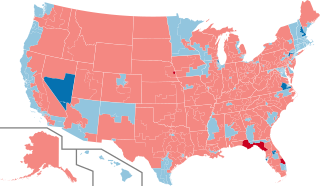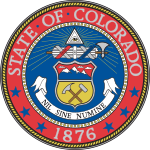The 1902 United States House of Representatives elections were held for the most part on November 4, 1902, with Oregon, Maine, and Vermont holding theirs early in either June or September. They occurred in the middle of President Theodore Roosevelt's first term, about a year after the assassination of William McKinley in September 1901. Elections were held for 386 seats of the United States House of Representatives, representing 45 states, to serve in the 58th United States Congress.

The 2010 United States elections were held on Tuesday, November 2, 2010, in the middle of Democratic President Barack Obama's first term. Republicans ended unified Democratic control of Congress and the presidency by winning a majority in the House of Representatives and gained seats in the Senate despite Democrats holding Senate control.

The 2002 United States elections were held on November 5, in the middle of Republican President George W. Bush's first term. Republicans won unified control of Congress, picking up seats in both chambers of Congress, making Bush the first president since Franklin D. Roosevelt in 1934 to gain seats in both houses of Congress. In the gubernatorial elections, Democrats won a net gain of one seat. The elections were held just a little under fourteen months after the September 11 attacks. Thus, the elections were heavily overshadowed by the War on Terror.

The 2012 United States elections took place on November 6, 2012. Democratic President Barack Obama won reelection to a second term and the Democrats gained seats in both chambers of Congress, retaining control of the Senate even though the Republican Party retained control of the House of Representatives. As of 2024, this is the most recent election cycle in which neither the presidency nor a chamber of Congress changed partisan control, and the last time that the party that won the presidency simultaneously gained seats in both the House of Representatives and the Senate.

The 2014 United States elections were held on Tuesday, November 4, 2014, in the middle of Democratic President Barack Obama's second term. A typical six-year itch midterm election suffered by most second-term presidents, this election saw the Republican Party retaining control of the House of Representatives and winning control of the Senate, while furthering their gains in the governorships and state legislatures. Because of these Republican gains, the election was commonly cited as a "red wave" election.

The 2018 United States elections were held on Tuesday, November 6, 2018. These midterm elections occurred during Incumbent Republican President Donald Trump's term. Although the Republican Party increased its majority in the Senate, unified Republican control of Congress and the White House was brought to an end when the Democratic Party won control of the House of Representatives in what was widely characterized as a "blue wave" election as Democrats also gained governorships, other statewide offices, and state legislative chambers.

The 2016 United States House of Representatives elections were held on November 8, 2016, to elect representatives for all 435 congressional districts across each of the 50 U.S. states to the 115th United States Congress. Non-voting members for the District of Columbia and territories of the United States were also elected. These elections coincided with the election of President Donald Trump, although his party lost seats in both chambers of Congress. The winners of this election served in the 115th Congress, with seats apportioned among the states based on the 2010 United States census. In October 2015, the House elected a new Speaker, Republican Paul Ryan, who was re-elected in the new term. Democrat Nancy Pelosi continued to lead her party as Minority Leader. Elections were also held on the same day for the U.S. Senate, many governors, and other state and local elections.

The 2016 United States House of Representatives elections in Colorado were held on November 8, 2016, to elect the seven U.S. representatives from the state of Colorado, one from each of the state's seven congressional districts. The elections coincided with the 2016 U.S. presidential election, as well as other elections to the House of Representatives, elections to the United States Senate and various state and local elections. The primaries were held on June 28.

The 2018 Colorado House of Representatives elections took place as part of the biennial United States elections. Colorado voters elected state representatives in all 65 of the state house's districts. State representatives serve two-year terms in the Colorado House of Representatives. The Colorado Reapportionment Commission provides a statewide map of the state House here, and individual district maps are available from the U.S. Census here.

The 2018 Colorado State Senate elections took place as part of the biennial United States elections. Colorado voters elected state senators in 17 of the 35 districts in the state senate. State senators serve four-year terms in the Colorado State Senate. The Colorado Reapportionment Commission provides a statewide map of the state Senate here, and individual district maps are available from the U.S. Census here.

The 2020 Nevada Senate election was held on Tuesday, November 3, 2020. Voters in 10 districts of the Nevada Senate elected senators. The elections coincided with the elections for other offices, including for U.S. President, U.S. House and the Nevada Assembly. Republicans needed to gain three seats to win control of the chamber.

The 2020 Colorado House of Representatives elections took place on November 3, 2020, with the primary elections held on June 30, 2020. Voters in all 65 districts of the state House elected their representative for a two-year term. It coincided with the state Senate elections and the biennial United States elections. The Democratic Party retained control of the House of Representatives. The Democrats gained the 38th District while the Republicans gained the 47th District, resulting in no net seat change.

The 2020 Colorado Senate elections took place on November 3, 2020, with the primary elections held on June 30, 2020. Voters in 18 out of 35 districts of the state Senate elected their representative for a four-year term. It coincided with the state House elections and the biennial United States elections. The Democratic Party retained control of the Senate, winning 20 seats, and increased their majority by one, gaining the 27th district from the Republican Party.

Colorado state elections in 2020 were held on Tuesday, November 3, 2020. The deadline to register and receive a ballot by mail in Colorado was October 26, 2020. Voters may register in person and vote or pick up a ballot at Voter Service Centers October 19 through 7 p.m. November 3, 2020. Colorado exclusively used a vote-by-mail system, although voters may choose to vote in person at Voter Service and Polling Centers (VSPCs).

A general election was held in the U.S. state of Colorado on November 8, 2022. All of Colorado's executive officers were up for election, as well as all of Colorado's seats in the United States House of Representatives, and Colorado's U.S. Senate seat currently occupied by Michael Bennet.

The 2016 Colorado House of Representatives election was held on Tuesday, November 8, 2016, with the primary election being held on June 28, 2016. Voters in the 65 districts of the Colorado House of Representatives elected their representatives. The elections coincided with the elections for other offices, including for U.S. President and the state senate. Democrats expanded their majority in the chamber, winning back all three seats which they lost in 2014.

The 2022 Colorado House of Representatives elections took place on November 8, 2022, along with the elections in the State Senate. The primary elections were held on June 28, 2022. Voters in all 65 districts of the state House elected their representative for a two-year term. These coincided with other Colorado elections of the same year and the biennial United States elections.

The 2022 Colorado Senate elections took place on November 8, 2022, along with elections in the State House of Representatives, with the primary elections held on June 28, 2022. Voters in 17 out of the 35 districts of the Colorado Senate elected their representative for a four-year term. It coincided with other Colorado elections of the same year and the biennial United States elections.

The 2014 Colorado Senate elections were held on November 4, 2014 to elect 18 of the 35 members of the Colorado Senate. The election coincided with Colorado House of Representatives elections and other state and federal elections. Primary elections were held on June 24, 2014. Republicans gained control of the chamber for the first time since 2005, gaining one seat.

The 2016 United States state legislative elections were held on November 8, 2016, for 86 state legislative chambers in 44 states. Across the fifty states, approximately 65 percent of all upper house seats and 85 percent of all lower house seats were up for election. Nine legislative chambers in the five permanently-inhabited U.S. territories and the federal district of Washington, D.C. also held elections. The elections took place concurrently with several other federal, state, and local elections, including the presidential election, U.S. Senate elections, U.S. House elections, and gubernatorial elections.
















